Exploring Don Quixote: Summary and Insights


Intro
"Don Quixote," written by Miguel de Cervantes, is often regarded as one of the pillars of Western literature. This novel, with its rich tapestry of characters and profound thematic elements, takes readers on a journey through the mind of a man who believes he is a knight destined for adventures beyond his wildest dreams. Through its narrative, Cervantes not only entertains but also critiques the very fabric of society during his time, making the text astonishingly relevant even in today's world.
At the heart of this exploration is the protagonist, Don Quixote himself, who embarks on a quest to restore chivalry and confronts the stark contrast between his ideals and the harsh reality around him. Beyond the whimsical escapades lies a profound social commentary on the nature of identity, sanity, and reality. This article aims to dissect the key themes presented in "Don Quixote," providing insights that resonate with modern audiences looking for deeper meanings in classic literature.
Through critical examination of character development, narrative structure, and thematic depth, readers can gain a comprehensive understanding of the novel's significance and its enduring impact.
Prelims to Don Quixote
What makes Don Quixote a cornerstone of literature? Born from the mind of Miguel de Cervantes in the early 17th century, this work isn’t just a story about a man who mistakes windmills for giants. It is rich in layers that reflect societal norms, human nature, and the struggles between reality and illusion. Introducing readers to this novel means unraveling multiple threads that intertwine individual aspirations with broader societal implications.
The essence of this introduction is two-fold: to set the stage for understanding the intricate narrative and to inspire a sense of connection with Cervantes' world. As one walks through the pages of Don Quixote, it becomes evident that the protagonist’s quest is not solely heroic; it is deeply flawed, making it relatable in ways that resonate even today. This journey both captures the imagination and invites critical thought, perfectly setting up an engaging exploration.
Historical Context
To fully appreciate Don Quixote, one must consider the historical backdrop of early 17th-century Spain. The period was marked by decline in the power of the Spanish Empire, economic troubles, and the remnants of the Reconquista. Cervantes, having lived through personal hardships, including captivity and poverty, painted a vivid portrait of his time and place.
This era saw the rise of the middle class, which contrasts sharply with the old nobility depicted through characters like Don Quixote, who clings to a romanticized vision of chivalry. Cervantes uses this historical context not just for setting but as a canvas to explore lasting themes of disillusionment and the dreams that dare to defy reality.
When we think about the pressures of society and the rigid expectations placed on individuals, Cervantes’ work echoes the timeless struggle many face: to dream in a world that prioritizes pragmatism.
Overview of Author Miguel de Cervantes
Miguel de Cervantes is more than just the author of Don Quixote; he is a symbol of resilience and creativity. Born in 1547, his life was a tapestry woven with diverse experiences, including serving as a soldier, being held as a captive, and facing financial difficulties. Each of these facets contributed to his storytelling.
Cervantes' writing is characterized by sharp wit and poignant observations. Don Quixote exemplifies this, blending humor with profound insights into human nature. His ability to create characters who are both absurd and tragically relatable showcases his deep understanding of humanity.
He didn't just create a novel; he opened a window into the human spirit. Through his work, Cervantes challenges readers to not only see the folly of his characters but also to reflect on their own aspirations and the dichotomy between dreams and reality.
"In short, his work transcends borders and centuries, making Cervantes’ voice a universal one, still relevant to the discussions of idealism, folly, and the quest for meaning today."
Ultimately, the significance of Cervantes extends beyond literature; he holds a mirror to society, reminding us to ponder our motivations and the narratives we choose to live out.
Narrative Structure
Understanding the narrative structure of Don Quixote is essential for grasping how Cervantes crafts his narrative and how it affects the reader's experience. The structure sets the stage for character development and thematic exploration, enabling a deeper comprehension of the work’s complexities. Cervantes skillfully employs various narrative techniques which contribute to the rich tapestry of the story, ensuring it remains engaging and insightful across generations.
Parts and Chapters
Don Quixote is divided into two parts, published in 1605 and 1615. Each part contains a series of chapters that vary in length and thematic focus. This division is significant; it allows Cervantes to showcase the evolution of Don Quixote's character and his relationships with other figures, particularly Sancho Panza.
- First Part: The initial journey introduces the reader to Don Quixote's idealistic pursuits and his whimsical, if deluded, quests to become a knight. Each chapter serves as a standalone anecdote, contributing to the comedic and tragic dimensions of the narrative.
- Second Part: The later chapters reveal a more self-aware protagonist. Here, Don Quixote’s reality begins to blend with the worlds around him, leading to deeper reflections on the nature of illusion and reality itself. Cervantes’s choice to release the second part comes after the first gained notoriety, making his commentary on fame and literature particularly poignant.
Every chapter is like a stepping stone that leads to a deeper philosophical journey, where every adventure cracked open the complexities of human aspirations and folly. This episodic nature allows readers not only to digest the humor and drama piece by piece but also to consider how these stories interconnect and build a larger, cohesive narrative.
Point of View
Cervantes employs a unique point of view that adds to the layers of the narrative. The novel is primarily written in the third person, presenting an omniscient viewpoint. This narrative style allows the audience to witness Don Quixote’s adventures from a distance, yet also provides insight into the thoughts and emotions of various characters, including Sancho Panza.
- Layered Perspectives: The duality of Don Quixote and Sancho Panza’s perspectives creates a dynamic contrast between idealism and realism. While Don Quixote sees the world through a romantic and heroic lens, Sancho embodies a pragmatic view, often providing humor through his responses to Quixote’s outlandish visions. This interplay leads the reader to a more profound understanding of existence as both characters navigate the absurdity of their experiences.
- Cervantes’ Commentary: By using this narrative choice, Cervantes delves into the complexities of perspective and perception. The readers become aware of the societal judgments around them and are invited to question their views on morality and honor as they follow Don Quixote on his quests.
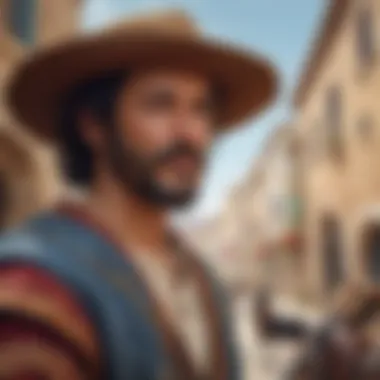

"Cervantes not only tells a story but also gives a lesson—every reader brings their habits and beliefs into the reading and thus interprets characters differently."
In combining these elements—parts and chapters with varied storytelling techniques, Cervantes constructs a rich narrative structure that resonates deeply with readers, provoking thought and discussion long after the final page.
Character Analysis
Understanding the characters in Don Quixote is critical for grasping the essence of Miguel de Cervantes' narrative. Character analysis not only reveals the motivations and personalities of the key figures but also sheds light on the broader themes and societal critiques embedded within the story. Through this exploration, readers can appreciate how the interactions between characters reflect the tensions between idealism and realism, a recurrent theme throughout the novel.
Don Quixote: The Idealist
Don Quixote, the protagonist of the novel, epitomizes the idea of idealism. His fervent belief in chivalry and his quest to revive knightly valor paint him as a romantic hero—albeit a misguided one. When he dons the armor and sets out on his adventures, he transforms from Alonso Quixano, a delusional hidalgo, into the knight-errant, Don Quixote de la Mancha.
This transformation is not simply a change in attire; it marks a profound shift in perception. He perceives the mundane world through a fantastical lens where inns become castles and windmills morph into giants. This ability to dream, although it often leads to humorous misadventures, highlights the importance of aspirations and ideals that can uplift the human spirit. However, it also raises questions about the cost of clinging to unattainable visions—often resulting in disillusionment.
Sancho Panza: The Realist
In stark contrast to Don Quixote is Sancho Panza, his loyal squire, who embodies realism. While Quixote's visions reflect a world of lofty ideals, Sancho is grounded in practical concerns. He dreams of the tangible rewards of his journey—governorship over an island, wealth, and the comforts of life. This dichotomy provides a rich tapestry for commentary on human nature.
Sancho's earthy wisdom often serves as a counterbalance to Quixote’s lofty aspirations. When Don Quixote charges at windmills, it is Sancho who, with common sense, tries to bring him back to reality, even if he does so in a somewhat humorous way, often saying, "They are not giants, but windmills." This interplay between the two characters illustrates how idealism and realism can coexist, yet often clash, in the face of life’s complexities.
Supporting Characters
The supporting characters in Don Quixote add layers of depth to the narrative and enrich the character study further. Each character interacts with both Don Quixote and Sancho Panza, offering contrasting perspectives and facilitating reflections on the central themes of the text:
- Dulcinea del Toboso: Though never appearing directly, her presence looms large in Quixote's mind. She represents the ultimate ideal for him—an unattainable love that drives many of his pursuits.
- Rocinante: Quixote’s noble steed is symbolic of his idealism, representing the lofty aspirations of its rider, even as it embodies the mundane reality of a worn-out horse.
- The Barber and the Priest: These characters often represent rationality. Their discussions about Quixote's fate often challenge the protagonist’s worldview, emphasizing the conflict between societal norms and personal dreams.
In sum, character analysis in Don Quixote fosters a deeper understanding of Cervantes' intricate exploration of human desires, ambitions, and the often harsh realities of life. The juxtaposition of characters like Don Quixote and Sancho Panza invites readers to reflect on their own ideals versus realities, enriching their engagement with the text.
"The truth is that one must believe in one’s own idealism to chase dreams, for sometimes the pursuit itself yields more than the reality one claims to seek."
Themes Explored in Don Quixote
In Miguel de Cervantes' Don Quixote, themes are not merely decorative elements; they are intricate threads that weave together the fabric of the narrative. Each theme serves as a lens through which readers can analyze the complexities of human existence, societal norms, and the often blurry lines between reality and illusion. This section delves into these themes, shedding light on how they enhance the reader's experience and understanding of the work as a whole.
The Nature of Reality and Illusion
Cervantes masterfully juxtaposes reality and illusion, forcing readers to ponder the essence of truth. Don Quixote, with his fervent belief in chivalric ideals, perceives a world vastly different from the one around him. Take, for instance, the iconic scene where he mistakes windmills for ferocious giants. This scenario is emblematic of his distorted view, where imagination trumps reality.
This theme encourages the reader to reflect on their own perceptions. Are we, like Quixote, blinded by our desires and beliefs? Ultimately, Cervantes conveys that the struggle between reality and illusion is not only a personal journey but a universal human condition. It serves as a reminder that how we interpret our surroundings can shape our actions and motivations.
Individual vs. Society
The relationship between the individual and society permeates the narrative, illustrating the conflicts that arise from personal ideals clashing with societal expectations. Quixote, a figure of idealism, embarks on a quest that reflects a deep yearning to restore a perceived chivalrous order. In contrast, Sancho Panza, who accompanies him, embodies the pragmatic approach to life, often reminding Quixote of the realities they face.
This dichotomy is further accentuated through various characters who either support or challenge Quixote's vision. The tension between the individual’s aspirations and collective societal norms sparks discussions about conformity, freedom, and disillusionment. As Quixote pursues his quests, the narrative raises critical questions regarding the cost of idealism and the influence of societal structures on personal behavior.
Chivalry and Honor
Chivalry and honor are pivotal motifs throughout Don Quixote. Quixote’s obsession with knighthood reflects a longing for a bygone era, where virtues such as bravery, loyalty, and honor were paramount. However, Cervantes employs a satirical tone, revealing the absurdity of Quixote's fervent beliefs in a world that has largely moved on from such ideals.
The character interactions serve to underscore the contradictions within the chivalric code. While Quixote seeks to embody these virtues, he often finds himself in comical—or tragic—failures when confronted with reality. This theme invites readers to analyze the relevance of honor in contemporary society. Is it merely a relic of the past, or does it still hold meaning in our modern world? The exploration of chivalry in Don Quixote sparks a discourse on ethics, morality, and the tensions between individual aspiration and societal values.
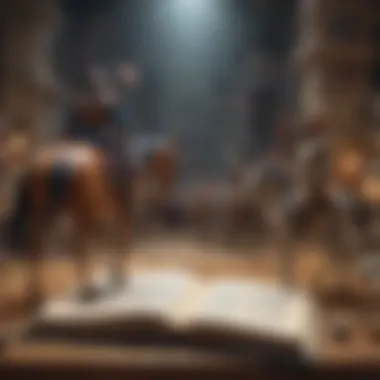
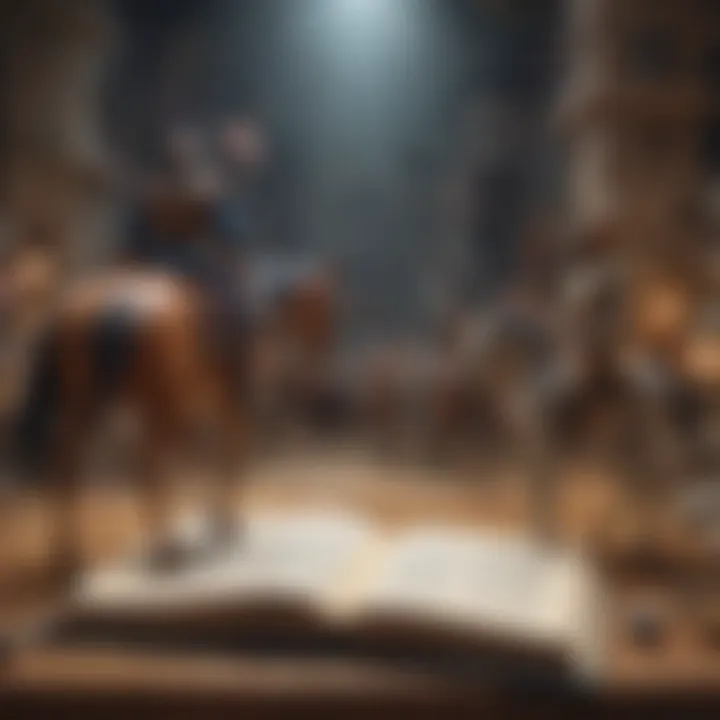
"The truth is that at this hour, I am as badly off as I could be, though no knight shall be more valiant than I any day."
– Don Quixote
Through these themes, Don Quixote emerges as a rich tapestry that invites readers to ponder significant philosophical questions about reality, the self, and the interplay with society. Cervantes channels these complex ideas into the adventures and misadventures of his characters, ensuring that the reader walks away with not just a story, but an invitation to introspection.
Symbolism and Motifs
In the rich tapestry of Don Quixote, symbolism and motifs serve as the connective tissue that binds together the numerous themes and characters of Miguel de Cervantes’ epic. These elements not only enhance the narrative but also deepen the reader's comprehension of the protagonist's journey and the societal critiques embedded within the story. As we dive into this section, it becomes clear that understanding these symbols and motifs sheds light on the complexities of reality and illusion that Cervantes masterfully explores.
Windmills as a Symbol
One of the most iconic symbols in Don Quixote are the windmills that Don Quixote famously mistakes for giants. This misinterpretation encapsulates the essence of his character—an idealist navigating through his perceived reality. The windmills stand as a metaphor for the obstacles in life, often larger in our minds than in reality. In essence, they symbolize the follies of human ambition and the fragility of dreams. Don Quixote's fierce charge at these windmills reveals a profound commentary on the persistence of hope in the face of ridiculous odds.
"When life gives you windmills, you ride into the sunset, even if they just spin in the wind."
The act of tilting at these windmills illustrates the broader theme of unattainable ideals. It challenges readers to ponder over the subjective nature of truth. Are these windmills mere inanimate objects, or do they represent the encumbrances that thwart our dreams? By tackling these mighty foes, Quixote embodies the struggle against life’s absurdities, raising questions about the nature of courage and folly.
The Journey as a Motif
The journey motif in Don Quixote unfolds as a multifaceted exploration of not just physical travel, but also a profound quest for identity and meaning. Cervantes intricately weaves the protagonist’s excursions across Spain with the internal journey of self-discovery. Every episode on the road is packed with lessons, encounters, and reflections that prompt both Don Quixote and the reader to confront the essence of dignity, honor, and self-worth.
Don Quixote's travels can be viewed as an allegory of life's journey, filled with encounters that shape one's worldview. Each stop along the way introduces the reader to diverse characters, each embodying different aspects of society and reflecting varied human experiences—from the noble to the ignoble, from dreamers to realists.
The road, in its winding paths and unforeseen challenges, mirrors the unpredictability of life itself. Just as Quixote meets countless strangers who provoke and teach him, readers, too, are invited to consider their own journeys—full of hope, disappointment, aspiration, and the quest for meaning.
In summary, the journey motif is not simply a backdrop for the adventures of Don Quixote; it is the core of his character and a mirror to the reader's soul, prompting reflection on who we are in an ever-changing world.
Cervantes’ Style and Literary Techniques
The style and literary techniques employed by Miguel de Cervantes in Don Quixote represent a distinctive approach that contributes significantly to the narrative's richness. Cervantes utilized a blend of humor, satire, and intricate narrative strategies that reflect his keen observations of human nature and society. Understanding these elements is crucial as they not only shape the reader’s experience but also provide deeper insights into the themes and characters of the novel.
Use of Humor and Satire
Cervantes’ work is deeply imbued with humor, which serves multiple purposes. Firstly, it acts as a vehicle for satire, allowing Cervantes to critique the absurdities prevalent in both chivalric literature and societal norms of his time. In the character of Don Quixote, for example, Cervantes highlights the ridiculousness of his fixation on chivalry and his subsequent misinterpretations of reality. This is not simply for comedic relief; it underscores the larger theme of illusion versus reality, prompting readers to reconsider the beliefs they hold dear.
Moreover, Cervantes often uses situational irony to enhance the humor. Take, for instance, the famous scene where Don Quixote engages with windmills, mistaking them for giants. This incident is not only laughable but also laden with commentary on the folly of idealism when divorced from reality.
Some key points regarding this use of humor and satire include:
- Critique of Idealism: Through comical situations, Cervantes exposes the pitfalls of excessive idealism, urging readers to find balance.
- Human Flaws: The humor in the text often reflects universal human flaws, fostering a connection with readers.
- Cultural Commentary: Satirical elements invite readers to engage with and critique their own societal standards and values.
"Cervantes crafts laughter not merely as entertainment but as a profound reflection on the follies of man."
Narrative Complexity
The narrative structure of Don Quixote is another facet of Cervantes’ literary prowess. There’s a noticeable complexity in how the story unfolds, marked by shifts between various storytelling styles. Cervantes employs a variety of voices: from straightforward narration to more intricate dialogues, each contributing to a multifaceted portrayal of events and characters.
One notable feature is the meta-textual element where characters often reference their awareness of being part of a story. This technique not only engages readers but also prompts them to question the nature of fiction itself. Cervantes plays with the boundaries of reality and imagination, blurring the lines between the two.
Some significant aspects of the narrative complexity include:
- Multiple Perspectives: By incorporating various viewpoints, Cervantes enriches the narrative, allowing for deeper character exploration.
- Intertextuality: References to other literary works create a dialogue between texts, enriching the themes and inviting critical thought.
- Non-linear Storytelling: The shifts in time and focus create a tapestry of experiences that mirror the chaotic nature of life itself.
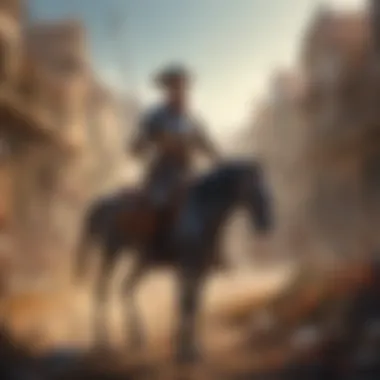
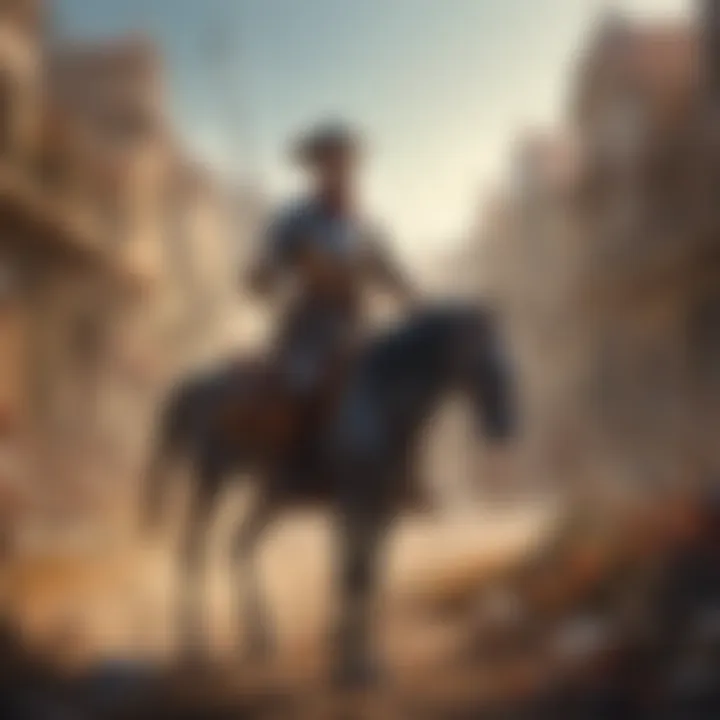
In summary, the techniques Cervantes employs in Don Quixote—both humor and a layered narrative structure—work in tandem to engage readers on multiple levels. They encourage reflection on deeper social criticisms, character motivations, and the perennial tug-of-war between ideals and reality.
Cultural Impact and Legacy
The cultural impact and legacy of Don Quixote extend far beyond its pages; it has shaped literature, art, and various aspects of popular culture for hundreds of years. This section delves into the significance of Cervantes' work in influencing literary traditions and its adaptations across different mediums, as well as its lasting relevance in contemporary society.
Influence on Literature
When we talk about the influence of Don Quixote, we enter a world where Cervantes redefined the boundaries of storytelling. Before Cervantes, novels largely followed rigid structures or focused on historical or romantic events. Cervantes bent those rules, creating a more nuanced, complex narrative that weaves together multiple voices and points of view. Such innovation paved the way for later authors like Charles Dickens and Fyodor Dostoevsky, who adopted and expanded on the techniques of character development and psychological depth found in Don Quixote.
- The concept of the unreliable narrator can trace its roots back to Cervantes, as Don Quixote himself often presents an altered version of reality, confusing the reader as much as he confuses himself.
- Modern literary movements such as existentialism, post-modernism, and magical realism owe debts to Cervantes's ability to blend reality with fantasy.
- Works like The Adventures of Huckleberry Finn by Mark Twain show clear parallels in their roguish protagonists who navigate a society that is, at times, nonsensical, much like Quixote’s chivalric adventures.
As such, Cervantes has become a touchstone for writers facing their own societal dilemmas, social critiques, and the absurdity of life.
Adaptations in Other Media
Don Quixote has not been limited to literary realms, either. Its story has transcended into various forms of media, influencing countless adaptations that reinterpret its themes and characters. This versatility reflects the timeless qualities of Cervantes's narrative.
- Film: The novel has been adapted into numerous films, ranging from silent films to contemporary animated features. Notably, Don Quixote has been portrayed by renowned actors like Orson Welles and Johnny Depp, each bringing their unique spin on the character of the deluded knight.
- Theatre: Stage adaptations, such as the musical Man of La Mancha, have become iconic, encapsulating the essence of the character and his eternal struggle against societal norms. This musical, in particular, emphasizes themes of idealism and hope in a disillusioned world, echoing Cervantes's original intentions.
- Visual Arts: Artists like Pablo Picasso and Salvador Dalí have drawn inspiration from the novel, creating works that capture its surreal aspects. Dalí's interpretation of Don Quixote features bizarre imagery that resembles the chaotic nature of Cervantes's storytelling, while Picasso's sketches reflect the emotional depth and irony present in the text.
"Cervantes's Don Quixote remains a mirror held up to all human experience, with its layers of irony, humor, and profound insight."
Overall, the cultural legacy of Don Quixote symbolizes the enduring human quest for identity, purpose, and connection, thus maintaining its relevance not just in literature but in every facet of modern expression.
Contemporary Relevance
The themes woven into Don Quixote remain deeply relevant in our present-day society. This exploration into idealism and realism sets a backdrop for understanding not only the characters and their journeys but also the dilemmas we face in our everyday lives. In a world saturated with complexities, Cervantes prompts contemporary readers to grapple with the tensions between lofty aspirations and harsh realities.
Lessons on Idealism and Realism
In Cervantes' narrative, the figure of Don Quixote embodies the quintessence of idealism. His dreams and quests, while noble at heart, often collide with the stark realities of life. This dichotomy is not merely a relic of literary history; it resonates in today's context as well. Many individuals are caught between their aspirations—be it personal, professional, or social—and the pragmatic challenges that curb those ambitions.
For instance, educators today can see reflections of Don Quixote in the rising enthusiasm of students who enter higher education chasing dreams of changing the world. This former knight's adventures can serve as a lesson about persistence and the importance of pursuing one's ideals, while also recognizing the necessity of grounding those ideals in realistic terms. Facing situations as they are, without the lens of delusion, can lead to a healthier form of idealism—one that embraces both dreams and practicality.
Cervantes also hints at the perils of losing one's grip on reality. Don Quixote's battles against imagined foes shed light on what can happen when aspirations tip into obsession. This lesson holds significant weight for today's professionals who might find themselves chasing an idealized version of success, sometimes to the detriment of their well-being or relationships.
Reflections on Society Today
Don Quixote acts not only as a mirror to individual experiences but as a reflection of societal values and disputes. The novel poses critical questions about the societal roles we play and the expectations we uphold. For instance, the tension between traditional values bolstered by chivalric ideals and modern conflicts is seen in our political and social environments.
In today's world, where we have the luxury of dialogue across diverse platforms—whether social media or community forums—Cervantes' examination of the clash between reality and illusion provides a necessary counterbalance. He provokes us to consider the narratives we construct about ourselves and others.
The relevance of this story extends further into the rapidly changing technological landscape we live in. As we frequently engage with curated realities through social media, the lessons of self-awareness and humility highlighted in Don Quixote can guide individuals in distinguishing between what is genuine versus what is a façade.
Culmination
The conclusion serves as a pivotal element in any analytical exploration of Don Quixote. It brings forth the essential comprehension of the themes, characters, and narrative structure discussed throughout the article while drawing connections between Cervantes' work and its contemporary relevance.
Summary of Key Takeaways
The key takeaways from our comprehensive study on Don Quixote include:
- The Duality of Idealism and Realism: The contrast between Don Quixote's lofty ideals and Sancho Panza's practical outlook highlights a fundamental tension that resonates with readers.
- Narrative Complexity and Richness: Cervantes' intricate storytelling intertwined with humor provides layers of meaning, making it a timeless work.
- Themes of Reality vs. Illusion: The novel poses critical questions about perception and truth, which remain relevant.
- Cultural and Literary Impact: Don Quixote set the stage for future literary movements, influencing countless works across genres.
- Social Commentary: Cervantes' social critiques invite reflection on societal norms, a value that echoes loudly even today.
Final Thoughts on Reading Don Quixote
Reading Don Quixote is not merely about following the adventures of a knight and his squire. It plunges the reader into a labyrinth of thought-provoking themes and vibrant character dynamics. Engagers of this text are often left pondering their own perceptions of reality and the struggles between one’s dreams and the harshness of the world.
Ultimately, the importance of Don Quixote lies not solely in its narrative but in its ability to challenge readers to introspect. As politicians, philosophers, and everyday folk navigate the realms of idealism and practicality, Cervantes offers a mirror through which we can examine our values and aspirations. Thus, Don Quixote stands as a testament to the complexities of human experience, inviting readers to embark on their own journeys of understanding.















